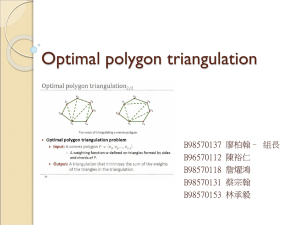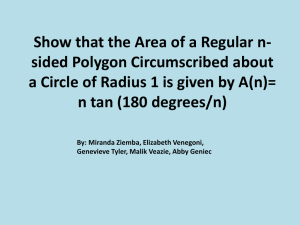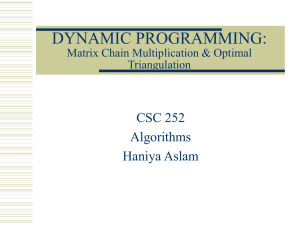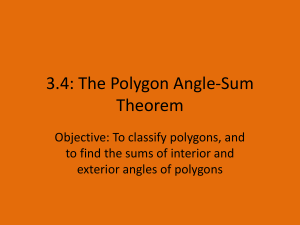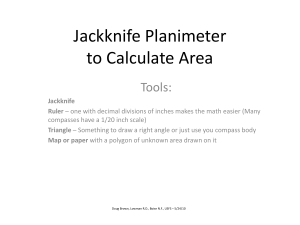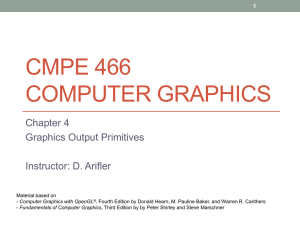A i…j
advertisement
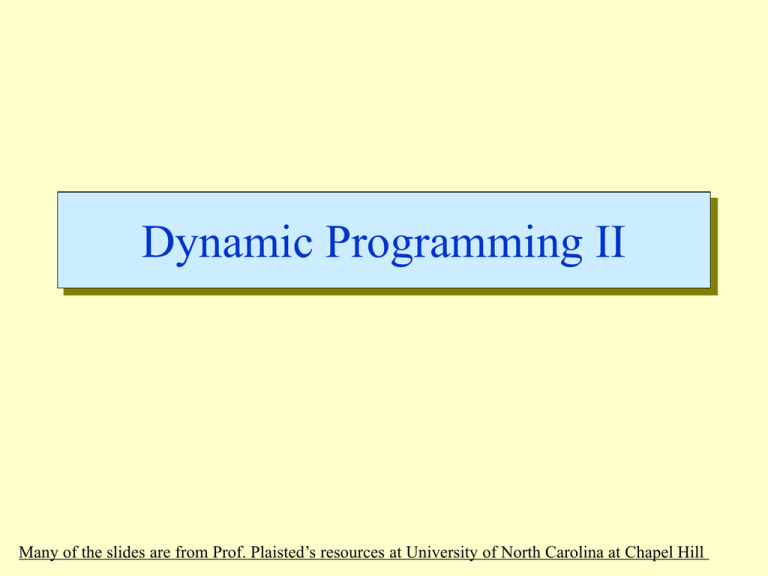
Dynamic Programming II Many of the slides are from Prof. Plaisted’s resources at University of North Carolina at Chapel Hill Dynamic Programming Similar to divide-and-conquer, it breaks problems down into smaller problems that are solved recursively. In contrast, DP is applicable when the sub-problems are not independent, i.e. when sub-problems share sub-sub-problems. It solves every sub-sub-problem just once and save the results in a table to avoid duplicated computation. Elements of DP Algorithms Sub-structure: decompose problem into smaller subproblems. Express the solution of the original problem in terms of solutions for smaller problems. Table-structure: Store the answers to the sub-problem in a table, because sub-problem solutions may be used many times. Bottom-up computation: combine solutions on smaller sub-problems to solve larger sub-problems, and eventually arrive at a solution to the complete problem. Applicability to Optimization Problems Optimal sub-structure (principle of optimality): for the global problem to be solved optimally, each sub-problem should be solved optimally. This is often violated due to sub-problem overlaps. Often by being “less optimal” on one problem, we may make a big savings on another sub-problem. Small number of sub-problems: Many NP-hard problems can be formulated as DP problems, but these formulations are not efficient, because the number of sub-problems is exponentially large. Ideally, the number of sub-problems should be at most a polynomial number. Optimized Chain Operations Determine the optimal sequence for performing a series of operations. (the general class of the problem is important in compiler design for code optimization & in databases for query optimization) For example: given a series of matrices: A1…An , we can “parenthesize” this expression however we like, since matrix multiplication is associative (but not commutative). Multiply a p x q matrix A times a q x r matrix B, the result will be a p x r matrix C. (# of columns of A must be equal to # of rows of B.) Matrix Multiplication In particular for 1 i p and 1 j r, C[i, j] = k = 1 to q A[i, k] B[k, j] Observe that there are pr total entries in C and each takes O(q) time to compute, thus the total time to multiply 2 matrices is pqr. Chain Matrix Multiplication Given a sequence of matrices A1 A2…An , and dimensions p0 p1…pn where Ai is of dimension pi-1 x pi , determine multiplication sequence that minimizes the number of operations. This algorithm does not perform the multiplication, it just figures out the best order in which to perform the multiplication. Example: CMM Consider 3 matrices: A1 be 5 x 4, A2 be and A3 be 6 x 2. 4 x 6, Mult[((A1 A2)A3)] = (5x4x6) + (5x6x2) = 180 Mult[(A1 (A2A3 ))] = (4x6x2) + (5x4x2) = 88 Even for this small example, considerable savings can be achieved by reordering the evaluation sequence. Naive Algorithm If we have just 1 item, then there is only one way to parenthesize. If we have n items, then there are n-1 places where you could break the list with the outermost pair of parentheses, namely just after the first item, just after the 2nd item, etc. and just after the (n-1)th item. When we split just after the kth item, we create two sub-lists to be parenthesized, one with k items and the other with n-k items. Then we consider all ways of parenthesizing these. If there are L ways to parenthesize the left sub-list, R ways to parenthesize the right sub-list, then the total possibilities is LR. Cost of Naive Algorithm The number of different ways of parenthesizing n items is P(n) = 1, if n = 1 P(n) = k = 1 to n-1 P(k)P(n-k), if n 2 This is related to Catalan numbers (which in turn is related to the number of different binary trees on n nodes). Specifically P(n) = C(n-1). C(n) = (1/(n+1)) C(2n, n) (4n / n3/2) where C(2n, n) stands for the number of various ways to choose n items out of 2n items total. DP Solution (I) Let Ai…j be the product of matrices i through j. Ai…j is a pi-1 x pj matrix. At the highest level, we are multiplying two matrices together. That is, for any k, 1 k n-1, A1…n = (A1…k)(Ak+1…n) The problem of determining the optimal sequence of multiplication is broken up into 2 parts: Q : How do we decide where to split the chain (what k)? A : Consider all possible values of k. Q : How do we parenthesize the subchains A1…k & Ak+1…n? A : Solve by recursively applying the same scheme. NOTE: this problem satisfies the “principle of optimality”. Next, we store the solutions to the sub-problems in a table and build the table in a bottom-up manner. DP Solution (II) For 1 i j n, let m[i, j] denote the minimum number of multiplications needed to compute Ai…j . Example: Minimum number of multiplies for A3…7 A1 A2 A3 A4 A5 A6 A7 A8 A9 m[ 3, 7 ] In terms of pi , the product A3…7 has dimensions ____. DP Solution (III) The optimal cost can be described be as follows: » i = j the sequence contains only 1 matrix, so m[i, j] = 0. » i < j This can be split by considering each k, i k < j, as Ai…k (pi-1 x pk ) times Ak+1…j (pk x pj). This suggests the following recursive rule for computing m[i, j]: m[i, i] = 0 m[i, j] = mini k < j (m[i, k] + m[k+1, j] + pi-1pkpj ) for i < j Computing m[i, j] For a specific k, (Ai …Ak)( Ak+1 … Aj) = m[i, j] = mini k < j (m[i, k] + m[k+1, j] + pi-1pkpj ) Computing m[i, j] For a specific k, (Ai …Ak)( Ak+1 … Aj) = Ai…k( Ak+1 … Aj) (m[i, k] mults) m[i, j] = mini k < j (m[i, k] + m[k+1, j] + pi-1pkpj ) Computing m[i, j] For a specific k, (Ai …Ak)( Ak+1 … Aj) = Ai…k( Ak+1 … Aj) = Ai…k Ak+1…j (m[i, k] mults) (m[k+1, j] mults) m[i, j] = mini k < j (m[i, k] + m[k+1, j] + pi-1pkpj ) Computing m[i, j] For a specific k, (Ai …Ak)( Ak+1 … Aj) = Ai…k( Ak+1 … Aj) = Ai…k Ak+1…j = Ai…j (m[i, k] mults) (m[k+1, j] mults) (pi-1 pk pj mults) m[i, j] = mini k < j (m[i, k] + m[k+1, j] + pi-1pkpj ) Computing m[i, j] For a specific k, (Ai …Ak)( Ak+1 … Aj) = Ai…k( Ak+1 … Aj) = Ai…k Ak+1…j = Ai…j (m[i, k] mults) (m[k+1, j] mults) (pi-1 pk pj mults) For solution, evaluate for all k and take minimum. m[i, j] = mini k < j (m[i, k] + m[k+1, j] + pi-1pkpj ) Matrix-Chain-Order(p) 1. n length[p] - 1 2. for i 1 to n // initialization: O(n) time 3. do m[i, i] 0 4. for L 2 to n // L = length of sub-chain 5. do for i 1 to n - L+1 6. do j i + L - 1 7. m[i, j] 8. for k i to j - 1 9. do q m[i, k] + m[k+1, j] + pi-1 pk pj 10. if q < m[i, j] 11. then m[i, j] q 12. s[i, j] k 13. return m and s Analysis The array s[i, j] is used to extract the actual sequence (see next). There are 3 nested loops and each can iterate at most n times, so the total running time is (n3). Extracting Optimum Sequence Leave a split marker indicating where the best split is (i.e. the value of k leading to minimum values of m[i, j]). We maintain a parallel array s[i, j] in which we store the value of k providing the optimal split. If s[i, j] = k, the best way to multiply the sub-chain Ai…j is to first multiply the sub-chain Ai…k and then the sub-chain Ak+1…j , and finally multiply them together. Intuitively s[i, j] tells us what multiplication to perform last. We only need to store s[i, j] if we have at least 2 matrices & j > i. Mult (A, i, j) 1. if (j > i) 2. then k = s[i, j] 3. X = Mult(A, i, k) // X = A[i]...A[k] 4. Y = Mult(A, k+1, j) // Y = A[k+1]...A[j] 5. return X*Y // Multiply X*Y 6. else return A[i] // Return ith matrix Example: DP for CMM The initial set of dimensions are <5, 4, 6, 2, 7>: we are multiplying A1 (5x4) times A2 (4x6) times A3 (6x2) times A4 (2x7). Optimal sequence is (A1 (A2A3 )) A4. Finding a Recursive Solution Figure out the “top-level” choice you have to make (e.g., where to split the list of matrices) List the options for that decision Each option should require smaller subproblems to be solved Recursive function is the minimum (or max) over all the options m[i, j] = mini k < j (m[i, k] + m[k+1, j] + pi-1pkpj ) Steps in DP: Step 1 Think what decision is the “last piece in the puzzle” » Where to place the outermost parentheses in a matrix chain multiplication (A1) (A2 A3 A4) (A1 A2) (A3 A4) (A1 A2 A3) (A4) DP Step 2 Ask what subproblem(s) would have to be solved to figure out how good your choice is » How to multiply the two groups of matrices, e.g., this one (A1) (trivial) and this one (A2 A3 A4) DP Step 3 Write down a formula for the “goodness” of the best choice m[i, j] = mini k < j (m[i, k] + m[k+1, j] + pi-1pkpj ) DP Step 4 Arrange subproblems in order from small to large and solve each one, keeping track of the solutions for use when needed Need 2 tables » One tells you value of the solution to each subproblem » Other tells you last option you chose for the solution to each subproblem Matrix-Chain-Order(p) 1. n length[p] - 1 2. for i 1 to n // initialization: O(n) time 3. do m[i, i] 0 4. for L 2 to n // L = length of sub-chain 5. do for i 1 to n - L+1 6. do j i + L - 1 7. m[i, j] 8. for k i to j - 1 9. do q m[i, k] + m[k+1, j] + pi-1 pk pj 10. if q < m[i, j] 11. then m[i, j] q 12. s[i, j] k 13. return m and s Assembly-Line Scheduling Two parallel assembly lines in a factory, lines 1 and 2 Each line has n stations Si,1…Si,n For each j, S1, j does the same thing as S2, j , but it may take a different amount of assembly time ai, j Transferring away from line i after stage j costs ti, j Also entry time ei and exit time xi at beginning and end Assembly Lines Finding Subproblem Pick some convenient stage of the process » Say, just before the last station What’s the next decision to make? » Whether the last station should be S1,n or S2,n What do you need to know to decide which option is better? » What the fastest times are for S1,n & S2,n Recursive Formula for Subproblem Fastest time to any given station =min Fastest time through prev station (other line) ( + Fastest time through prev station (same line) Time it takes to switch lines , ) Recursive Formula (II) Let fi [ j] denote the fastest possible time to get the chassis through S i, j Have the following formulas: f1[ 1] = e1 + a1,1 f1[ j] = min( f1[ j-1] + a1, j, f2 [ j-1]+t2, j-1+ a1, j ) Total time: f * = min( f1[n] + x1, f2 [ n]+x2) Analysis Only loop is lines 3-13 which iterate n-1 times: Algorithm is O(n). The array l records which line is used for each station number Example Polygons A polygon is a piecewise linear closed curve in the plane. We form a cycle by joining line segments end to end. The line segments are called the sides of the polygon and the endpoints are called the vertices. A polygon is simple if it does not cross itself, i.e. if the edges do not intersect one another except for two consecutive edges sharing a common vertex. A simple polygon defines a region consisting of points it encloses. The points strictly within this region are in the interior of this region, the points strictly on the outside are in its exterior, and the polygon itself is the boundary of this region. Convex Polygons A simple polygon is said to be convex if given any two points on its boundary, the line segment between them lies entirely in the union of the polygon and its interior. Convexity can also be defined by the interior angles. The interior angles of vertices of a convex polygon are at most 180 degrees. Triangulations Given a convex polygon, assume that its vertices are labeled in counterclockwise order P=<v0,…,vn-1>. Assume that indexing of vertices is done modulo n, so v0 = vn. This polygon has n sides, (vi-1 ,vi ). Given two nonadjacent vj , where i < j, the line segment (vi ,vj ) is a chord. (If the polygon is simple but not convex, a segment must also lie entirely in the interior of P for it to be a chord.) Any chord subdivides the polygon into two polygons. A triangulation of a convex polygon is a maximal set T of chords. Every chord that is not in T intersects the interior of some chord in T. Such a set of chords subdivides interior of a polygon into set of triangles. Example: Polygon Triangulation Dual graph of the triangulation is a graph whose vertices are the triangles, and in which two vertices share an edge if the triangles share a common chord. NOTE: the dual graph is a free tree. In general, there are many possible triangulations. Minimum-Weight Convex Polygon Triangulation The number of possible triangulations is exponential in n, the number of sides. The “best” triangulation depends on the applications. Our problem: Given a convex polygon, determine the triangulation that minimizes the sum of the perimeters of its triangles. Given three distinct vertices, vi , vj and vk , we define the weight of the associated triangle by the weight function w(vi , vj , vk) = |vi vj | + |vj vk | + |vk vi |, where |vi vj | denotes length of the line segment (vi ,vj ). Correspondence to Binary Trees In MCM, the associated binary tree is the evaluation tree for the multiplication, where the leaves of the tree correspond to the matrices, and each node of the tree is associated with a product of a sequence of two or more matrices. Consider an (n+1)-sided convex polygon, P=<v0,…,vn> and fix one side of the polygon, (v0 ,vn). Consider a rooted binary tree whose root node is the triangle containing side (v0 ,vn), whose internal nodes are the nodes of the dual tree, and whose leaves correspond to the remaining sides of the tree. The partitioning of a polygon into triangles is equivalent to a binary tree with n-1 leaves, and vice versa. Binary Tree for Triangulation The associated binary tree has n leaves, and hence n-1 internal nodes. Since each internal node other than the root has one edge entering it, there are n-2 edges between the internal nodes. Lemma A triangulation of a simple polygon has n-2 triangles and n-3 chords. (Proof) The result follows directly from the previous figure. Each internal node corresponds to one triangle and each edge between internal nodes corresponds to one chord of triangulation. If we consider an n-vertex polygon, then we’ll have n-1 leaves, and thus n-2 internal nodes (triangles) and n-3 edges (chords). Another Example of Binary Tree for Triangulation DP Solution (I) For 1 i j n, let t[i, j] denote the minimum weight triangulation for the subpolygon <vi-1, vi ,…, vj>. We start with vi-1 rather than vi, to keep the structure as similar as possible to the matrix chain multiplication problem. v5 v4 v3 Min. weight triangulation = t[2, 5] v6 v2 v0 v1 DP Solution (II) Observe: if we can compute t[i, j] for all i and j (1 i j n), then the weight of minimum weight triangulation of the entire polygon will be t[1, n]. For the basis case, the weight of the trivial 2-sided polygon is zero, implying that t[i, i] = 0 (line (vi-1, vi)). DP Solution (III) In general, to compute t[i, j], consider the subpolygon <vi-1, vi ,…, vj>, where i j. One of the chords of this polygon is the side (vi-1, vj). We may split this subpolygon by introducting a triangle whose base is this chord, and whose third vertex is any vertex vk, where i k j-1. This subdivides the polygon into 2 subpolygons <vi-1,...vk> & <vk+1,... vj>, whose minimum weights are t[i, k] and t[k+1, j]. We have following recursive rule for computing t[i, j]: t[i, i] = 0 t[i, j] = mini k j-1 (t[i, k] + t[k+1, j] + w(vi-1vkvj )) for i < k Weighted-Polygon-Triangulation(V) 1. n length[V] - 1 // V = <v0 ,v1 ,…,vn> 2. for i 1 to n // initialization: O(n) time 3. do t[i, i] 0 4. for L 2 to n // L = length of sub-chain 5. do for i 1 to n-L+1 6. do j i + L - 1 7. t[i, j] 8. for k i to j - 1 9. do q t[i, k] + t[k+1, j] + w(vi-1 , vk , vj) 10. if q < t[i, j] 11. then t[i, j] q 12. s[i, j] k 13. return t and s
